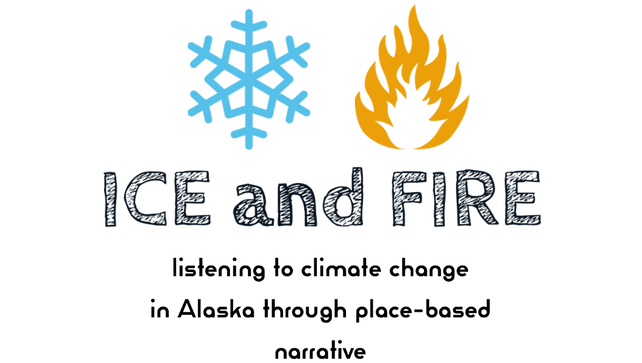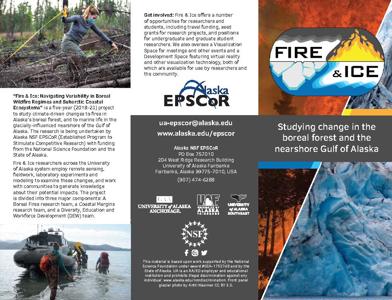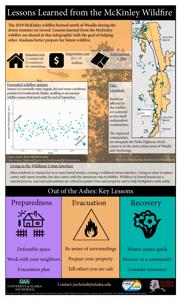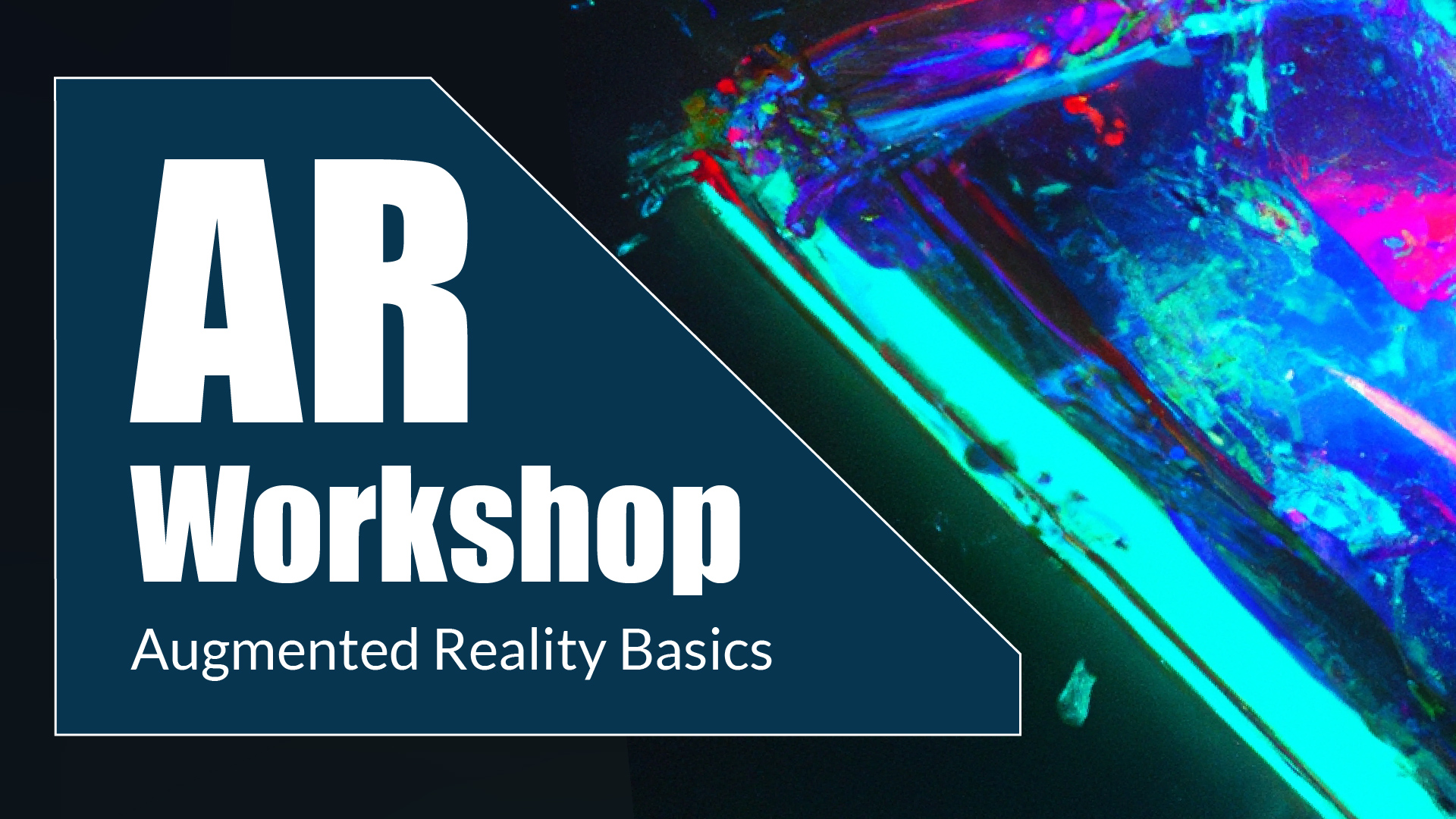Publications and Other Products
Fire & Ice disseminates research findings by publishing peer-reviewed scientific articles as well as a other kinds of products and project outcomes to translate findings into useful tools and informative media, including K-12 educuational materials, podcasts print publications, and recorded presenations. Also visit out Highlights page for additional outreach and science communication products.
Publications
Academic publications produced as part of the Fire & Ice project are listed below under each team. Since 2019, Fire & Ice researchers have produced at least 65 publications.
Badola, A., Panda, S.K., Roberts, D.A., Waigl, C.F., Bhatt, U.S., Smith, C.W., Jandt,
R.R. (2021). Hyperspectral data simulation (Sentinel-2 to AVIRIS-NG) for improved
wildfire fuel mapping, Boreal Alaska. Remote Sens., 13, 1693. https://doi.org/10.3390/rs13091693
Badola, A., Panda, S., Roberts, D.A., Waigl, C.F., Jandt, R.R. and Uma S. Bhatt. (2022).
A novel method to simulate AVIRIS-NG hyperspectral image from Sentinel-2 image for
improved vegetation/wildfire fuel mapping, boreal Alaska. International Journal of
Applied Earth Observation and Geoinformation, 112. https://doi.org/10.1016/j.jag.2022.102891
Badola, A., Panda, S. K., Thompson, D. R., Roberts, D. A., Waigl, C. F., & Bhatt,
U. S. (2023). Estimation and Validation of Sub-Pixel Needleleaf Cover Fraction in
the Boreal Forest of Alaska to Aid Fire Management. Remote Sensing, 15(10), 2484. https://doi.org/10.3390/rs15102484
Ballinger, T. J., Bhatt, U. S., Bieniek, P. A., Brettschneider, B., Lader, R. T.,
Littell, J. S., Thoman, R. L., Waigl, C. F., Walsh, J. E., & Webster, M. A. (2023).
Alaska Terrestrial and Marine Climate Trends, 1957–2021, Journal of Climate, 36(13),
4375-4391. https://doi.org/10.1175/JCLI-D-22-0434.1
Bar, S., Parida, B.R., Pandey, A.C., Shankar, B.U., Kumar, P., Panda, S.K., and Behera,
M.D. (2022) Modeling and prediction of fire occurrences along an elevational gradient
in Western Himalayas. Applied Geography, V. 151 (102867). https://doi.org/10.1016/j.apgeog.2022.102867
Bar, S., Parida B. R., Panda, S.K. (2022) Changing forest fire regime with relation
to climate conditions over western and eastern Himalaya, India in Handbook of Himalayan
Ecosystems and Sustainability, Vol. 1: Spatio-Temporal Monitoring of Forests and Climate,
Edited by B.R. Parida, CRC Press, Taylor & Francis Group. ISBN 9781032203140. https://www.taylorfrancis.com/chapters/edit/10.1201/9781003268383-19/changing-forest-fire-regime-relation-climatic-conditions-western-eastern-himalaya-india-somnath-bar-bikash-ranjan-parida-arvind-chandra-pandey-santosh-kumar-panda
Bhatt, U.S., Lader, R.T., Walsh, J.E., Bieniek, P.A., Thoman, R., Berman, M., Borries-Strigle,
C., Bulock, K., Chriest, J., Hahn, M., Hendricks, A.S., Jandt, R., Little, J., McEvoy,
D., Moore, C., Rupp, T.S., Schmidt, J., Stevens, E., Strader, H., Waigl, C., White,
J., York, A., and R. Ziel. (2021). Emerging anthropogenic influences on the Southcentral
Alaska temperature and precipitation extremes and related fires in 2019. Land, 10(1), 82. https://doi.org/10.3390/land10010082
Bhatt, U.S.; Carreras, B.A.; Newman, D.E.; Barredo, J.M.R.; Collet, P.; Gomila, D.
2022: The Potential Impact of Climate Change on the Efficiency and Reliability of
Solar, Hydro, and Wind Energy Sources. Land, 11, 1275. https://doi.org/10.3390/land11081275
Bieniek, P.A., Bhatt, U.S., York, A., Walsh, J.E., Lader, R., Strader, H., Ziel, R.,
Jandt, R.R. and Thoman, R. (2020). “Lightning variability in dynamically downscaled
simulations of Alaska’s present and future summer climate.” J. Appl. Meteor. Climatol., 59, 1139–1152. https://doi.org/10.1175/JAMC-D-19-0209.1.
Carreras, B.A., Reynolds-Barredo, J.M., Newman, D. E., Bhatt, U., Colet, P., Gomila,
D., (2022). A first analysis of the potential impact of climate change on the efficiency
and reliability of solar and hydro energy sources. HICSS, Proceedings of the 55th
Annual Hawaii International Conference on System Sciences (HICSS'22). DOI:10.24251/HICSS.2022.415
Carreras, B.A., Newman, D.E., Bhatt, U.S., Reynolds Barredo, J.M., Colet, P., and
Gomila G. (2023) An Initial Analysis of the Impact of Future Climate Change on the
Efficiency and Reliability of Solar, Wind and Hydro Energy Sources. HICSS, Proceedings
of the 56th Annual Hawaii International Conference on System Sciences (HICSS'23)
Hahn, M.B., Kuiper, G., O’Dell, K., Fischer, E.V., & S. Magzamen. (2021). Wildfire
smoke is associated with an increased risk of cardiorespiratory emergency department
visits in Alaska. GeoHealth, 5, e2020GH000349. https://doi.org/10.1029/2020GH000349
Jandt, R. and A. York. 2021. Alaska Burning: Wildfire is transforming the landscape
of the high north and amplifying climate change. Scientifc American, October: 42-49.
Miller, E.A., Jones, B.M., Baughman, C.A., Jandt, R.R., Jenkins, J.L., and D.A. Yokel.
2023. Unrecorded Tundra Fires of the Arctic Slope, Alaska USA. Fire 2023, 6, 101.
https://doi.org/10.3390/fire6030101
Sampath, A., Bhatt, U.S., Bieniek P.A., Ziel, R., York, A., Strader, H., Alden, S.,
Thoman, R., Brettschneider, B., Petrescu, E., Peng. P. and Sarah Mitchell. (2021).
Evaluation of seasonal forecasts for the fire season in Interior Alaska. Weather and Forecasting, 36(2), 601-613. https://doi.org/10.1175/WAF-D-19-0225.1
Schmidt, J. and See, J. (2023). Advancing Wildfire Preparedness and Planning in Anchorage
Wildfire Exposure and Egress Study. UAA ISER Website. https://s3.documentcloud.org/documents/23826762/anchorage-wildfire-egress-report.pdf
Scholten, R.C., Jandt, R., Miller, E.A. et al. Overwintering fires in boreal forests.
Nature, 593, 399–404 (2021). https://doi.org/10.1038/s41586-021-03437-y
Smith, C. W. , Panda, S.K., Bhatt, U.S., Meyer, F.J., Haan, R. W. (2020) Improved
vegetation and wildfire fuel type mapping using NASA AVIRIS-NG hyperspectral data,
interior Alaska. In conference proceedings of 2020 IEEE International Geoscience and
Remote Sensing Symposium scheduled to be help during July 19-24, 2020 at Waikoloa,
Hawaii, USA.
Smith, C.W., Panda, S.K., Bhatt, U.S., Meyer, F.J. (2021). Improved boreal forest
wildfire fuel type mapping in Interior Alaska Using AVIRIS-NG hyperspectral data.
Remote Sens., 13(5), 897. https://doi.org/10.3390/rs13050897
Smith, C.W.; Panda, S.K.; Bhatt, U.S.; Meyer, F.J.; Badola, A. and J.L. Hrobak. (2021).
Assessing wildfire burn severity and its relationship with environmental factors:
A case study in Interior Alaska boreal forest. Remote Sens., 13(10), 1966. https://doi.org/10.3390/rs13101966
York, A., Bhatt, U.S., Gargulinski, E., Grabinski, Z., Jain, P., Soja, A., Thoman,
R.L. and R. Ziel. (2020). Wildland fire in high northern latitudes. In: NOAA Arctic Report Card 2020, R.L. Thoman, J. Richter-Menge, and M.L. Druckenmiller, Eds. https://doi.org/10.25923/2gef-3964
York, A., Bhatt, U.S., Gargulinski, E., Grabinski, Z., Jain, P., Soja, A., Thoman,
R.L. and R. Ziel (2021). Arctic Report Card 2020: Wildland Fire in High Northern Latitudes.
Bulletin of the American Meteorological Society, 102(8). https://doi.org/10.25923/2gef-3964
Ziel, R.H., Bieniek, P.A., Bhatt, U.S., Strader, H., Rupp, T.S. and A. York. (2020).
“A comparison of fire weather indices with MODIS fire days for the natural regions
of Alaska forests.” Forests, 11(5): 516. https://doi.org/10.3390/f11050516
Bacus SC, Kelley AL (2023) Effects of ocean acidification and ocean warming on the
behavior and physiology of a subarctic, intertidal grazer. Mar Ecol Prog Ser 711:31-45.
https://doi.org/10.3354/meps14308
Beaudreau A.H., Bergstrom C.A., Whitney E.J., Duncan D.H. and N.C. Lundstrom (2022).
Seasonal and interannual variation in high‑latitude estuarine fish community structure
along a glacial to non‑glacial watershed gradient in Southeast Alaska. Environmental
Biology of Fishes. https://doi.org/10.1007/s10641-022-01241-9
Bellmore, R. J, J.B. Fellman, E. Hood, M.R. Dunkle, and R.T. Edwards (2022) A melting cryosphere constrains fish growth by synchronizing the seasonal phenology of river food webs. Global Change Biology. https://doi.org/10.1111/gcb.16273
Bidlack, A.L., Bisbing, S.M., Buma, B.J., Diefenderfer, H.L., Fellman, J.B., Floyd, W.C., Giesbrecht, I., Lally, A., Lertzman, K.P., Perakis, S.S., Butman, D.E, D'Amore, D.V., Fleming, S.W., Hood, E.W., Hunt, B.P.V., Kiffney, P.M., McNicol, G., Menounos, B. and S.E. Tank. (2021). Climate-mediated changes to linked terrestrial and marine ecosystems across the Northeast Pacific Coastal Temperate Rainforest margin. BioScience, biaa171. https://doi.org/10.1093/biosci/biaa171
Duncan, D.H. and A.H. Beaudreau. (2019). Spatiotemporal variation and size‐selective predation on hatchery‐ and wild‐born juvenile chum salmon at marine entry by nearshore fishes in Southeast Alaska. Marine and Coastal Fisheries, 11(5): 372-390. https://doi.org/10.1002/mcf2.10091
Edwards, R.T., D'Amore, D.V., Biles, F.E., Fellman, J.B., Hood, E.W., Trubilowicz, J.W., & W.C. Floyd. (2021). Riverine dissolved organic carbon and freshwater export in the eastern Gulf of Alaska. Journal of Geophysical Research: Biogeosciences, 126, e2020JG005725. https://doi.org/10.1029/2020JG005725
Fellman, J.B., Hood, E., Behnke, M.I., Welker, J.M., & R.G.M. Spencer. (2020). Stormflows drive stream carbon concentration, speciation, and dissolved organic matter composition in coastal temperate rainforest watersheds. Journal of Geophysical Research: Biogeosciences, 125, e2020JG005804. https://doi.org/10.1029/2020JG005804
Fellman, J.B., Hood, E., D’Amore, D.V. et al. (2021). Streamflow variability controls
N and P export and speciation from Alaskan coastal temperate rainforest watersheds.
Biogeochemistry, 152, 253–270. https://doi.org/10.1007/s10533-020-00752-w
Fellman, J.B., Bellmore, R.J., Johnson, C., Dunkle, M.R. and E. Hood, E. (2022) Glacier
runoff influences biogeochemistry and resource availability in coastal temperate rainforest
streams: Implications for juvenile salmon growth. Limnology and Oceanography, https://doi.org/10.1002/lno.12251
Giesbrecht, I. J. W., S.E. Tank, G.W. Frazer, E. Hood, S.G. Gonzalez Arriola, D.E. Butman, et al. (2022). Watershed classification predicts streamflow regime and organic carbon dynamics in the Northeast Pacific Coastal Temperate Rainforest. Global Biogeochemical Cycles, 36: e2021GB007047. https://doi.org/10.1029/2021GB007047
Hauri, C., Pagès, R., McDonnell, A.M.P. et al. (2021). Modulation of ocean acidification by decadal climate variability in the Gulf of Alaska. Commun Earth Environ 2, 191. https://doi.org/10.1038/s43247-021-00254-z
Hauri, C., Schultz, C., Hedstrom, K., Danielson, S., Irving. B., Doney, S.C., Dussin, R., Curchitser, E.N., Hill, D.F. and Charles A. Stock. (2020). A regional hindcast model simulating ecosystem dynamics, inorganic carbon chemistry and ocean acidification in the Gulf of Alaska. Biogeosciences, 17, 3837-3857. https://doi.org/10.5194/bg-17-3837-2020
Holt, A. D., Kellerman, A. M., Li, W., Stubbins, A., Wagner, S., McKenna, A., Fellman, J., Hood, E., and Spencer, R. G. M. (2021). Assessing the role of photochemistry in driving the composition of dissolved organic matter in glacier runoff. Journal of Geophysical Research: Biogeosciences, 126, e2021JG006516. https://doi.org/10.1029/2021JG006516
Holt, A.D., Fellman, J., Hood, E. et al. (2021). The evolution of stream dissolved organic matter composition following glacier retreat in coastal watersheds of southeast Alaska. Biogeochemistry. https://doi.org/10.1007/s10533-021-00815-6
Hood, E., Fellman, J. B., & R.G.M. Spencer. (2020). Glacier loss impacts riverine organic carbon transport to the ocean. Geophysical Research Letters, 47, e2020GL089804. https://doi.org/10.1029/2020GL089804
Hood, E., Fellman, J., Edwards, R.T., D’Amore, D.V., Scott, D. (2019). Salmon-derived nutrient and organic matter fluxes from a coastal catchment in southeast Alaska. Freshwater Biology, 64: 1157-1168. https://doi.org/10.1111/fwb.13292
Jenckes, J., Ibarra, D. E., & Munk, L. A. (2022). Concentration-discharge patterns
across the Gulf of Alaska reveal geomorphological and glacierization controls on stream
water solute generation and export. Geophysical Research Letters, 49, e2021GL095152.
https://doi.org/10.1029/2021GL095152
Jenckes, J., Munk, L. A., Ibarra, D. E., Boutt, D. F., Fellman, J., & Hood, E. (2023).
Hydroclimate drives seasonal riverine export across a gradient of glacierized high-latitude
coastal catchments. Water Resources Research, 59, e2022WR033305. https://doi.org/10.1029/2022WR033305
Jenson, A., Amundson, J. M., Kingslake, J., and Hood, E. (2022). Long-period variability in ice-dammed glacier outburst floods due to evolving catchment geometry. The Cryosphere, 16(1), 333–347. https://doi:10.5194/tc-16-333-2022
Johnson, M. (2021). Subtidal surface circulation in lower Cook Inlet and Kachemak Bay, Alaska. Regional Studies in Marine Science, 41, 101609. https://doi.org/0.1016/j.rsma.2021.101609
Kienholz, C., Pierce, J., Hood, E., Amundson, J.M., Wolken, G.J., Jacobs, A., Hart, S., Wikstrom-Jones, K., Abdel-Fattah, D., Johnson, C, and J.S. Conaway. (2020) Deglacierization of a marginal basin and implications for outburst floods, Mendenhall Glacier, Alaska. Frontiers in Earth Science, (8), 137. https://www.doi.org/10.3389/feart.2020.00137
Konar, B., Mitchell, T.J., Iken, K., Coletti, H., Dean, T., Esler, D., Lindeberg,
M., Pister, B. and B Weitzman. (2019). Wasting disease and static environmental variables
drive sea star assemblages in the Northern Gulf of Alaska. Journal of Experimental Marine Biology and Ecology, 520: 151209. https://doi.org/10.1016/j.jembe.2019.151209
LaBarre, A., B. Konar, and K. Iken. 2023. Influence of environmental conditions on
Mytilus trossulus size frequency distributions in two glacially influenced estuaries.
Estuaries and Coasts. https://doi.org/10.1007/s12237-023-01175-0
Lundstrom, N.C., Beaudreau, A.H., Mueter, F.J. and B. Konar (2022). Environmental drivers of nearshore fish community composition and size structure in glacially influenced Gulf of Alaska estuaries. Estuaries and Coasts. https://doi.org/10.1007/s12237-022-01057-x
McCabe, M.K. and Brenda Konar (2021). Influence of environmental attributes on intertidal community structure in glacial estuaries. Deep Sea Research Part II: Topical Studies in Oceanography, 194. https://doi.org/10.1016/j.dsr2.2021.104986
McNicol, G., Hood, E., Butman, D. E., Tank, S. E., Giesbrecht, I. J. W., Floyd, W.,
et al. (2023). Small, coastal temperate rainforest watersheds dominate dissolved organic
carbon transport to the northeast Pacific Ocean. Geophysical Research Letters, 50,
e2023GL103024. https://doi.org/10.1029/2023GL103024
Miller, C.A. & A.L. Kelley (2021). Alkalinity cycling and carbonate chemistry decoupling
in seagrass mystify processes of acidification mitigation. Sci Rep 11, 13500. https://doi.org/10.1038/s41598-021-92771-2
Myers, H.J., D.W. Olsen, C.O. Matkin, L.A. Horstmann, and B. Konar (2021). Passive acoustic monitoring of killer whales (Orcinus orca) reveals year-round distribution and residency patterns in the Gulf of Alaska. Scientific Reports. https://doi.org/10.1038/s41598-021-99668-0
Pitman, K.J, Moore, J.W., Sloat, M.R., Beaudreau, A.H., Bidlack, A.L., Brenner, R.E.,
Hood, E.W., Pess, G.R., Mantua, N.J., Milner, A.M., Radic, V., Reeves, G.H., Schindler,
D.E. and D.C. Whited. (2020). Glacial retreat and Pacific salmon. BioScience, 7(3): 220–236. https://doi.org/10.1093/biosci/biaa015
Pitman, K.J., J.W. Moore, M. Huss, M.R. Sloat, D. Whited, T. Beechie, E. Hood, D.E.
Schindler, A.M. Milner, R. Brenner, G.R. Pess, G.H. Reeves, and V. Radic (2021) Glacier
retreat creating new Pacific Salmon habitat in western North America, Nature Communications,
12:6816. https://doi.org/10.1038/s41467-021-26897-2
Russo, A. A., Boutt, D. F., Munk, L. A., & Jenckes, J. (2023). Contribution of Fresh
Submarine Groundwater Discharge to the Gulf of Alaska. Water Resources Research, 59,
e2023WR034912. https://doi.org/10.1029/2023WR034912
Ulaski, B.P., D.S. Sikes, and B. Konar. 2023. Beach-cast and drifting seaweed wrack
is an important resource for marine and terrestrial macroinvertebrates in high latitudes.
Marine Environmental Research. https://doi.org/10.1016/j.marenvres.2023.105970
Ulaski, B.P., Konar, B. and E.O. Otis. (2020). Seaweed reproduction and harvest rebound
in Southcentral Alaska: Implications for wild stock management. Estuaries and Coasts. https://doi.org/10.1007/s12237-020-00740-1
Ulaski, Brian P., Edward O. Otis, and Brenda Konar (2023) How landscape variables
influence the relative abundance, composition, and reproductive viability of macroalgal
wrack in a high latitude glacial estuary. Estuarine, Coastal and Shelf Science 280
: 108169. https://doi.org/10.1016/j.ecss.2022.108169
Umanzor, S., Sandoval-Gil, J.M. & Conitz, J. Ecophysiological Responses of the Intertidal
Seaweed Fucus Distichus to Temperature Changes and Reduced Light Driven by Tides and
Glacial Input. Estuaries and Coasts 46, 1269–1279 (2023). https://doi.org/10.1007/s12237-023-01207-9
Weitzman, B. and B. Konar. (2021). Biological correlates of sea urchin recruitment in kelp forest and urchin barren habitats. Marine Ecology Progress Series, 663, 115–125. https://doi.org/10.3354/meps13621
Williamson, E.R. & C.J. Sergeant (2021). Independent validation of downscaled climate
estimates from a coastal Alaska watershed using local historical weather journals.
PeerJ. https://doi.org/10.7717/peerj.12055
Young, J., E. Petit, A. Arendt, E. Hood, G. Liston, and J. Beamer (2021) A changing
hydrological regime: Trends in magnitude and timing of glacier ice melt and glacier
runoff in a high latitude coastal watershed, Water Resources Research, 57: e2020WR027404.
https://doi.org/10.1029/2020WR027404
Carsten Conner, L.D. & S. Perin. (2020). Learning from the real vs. the replicated: a comparative study. International Journal of Science Education, 10(3), 266-276. https://doi.org/10.1080/21548455.2020.1831707
Young, J., Carsten-Conner, L.D. and Erin Pettit (2020). ‘You really see it’: environmental identity shifts through interacting with a climate change-impacted glacier landscape. International Journal of Science Education, 42:18, 3049-3070. https://www.doi.org/10.1080/09500693.2020.1851065
Young, J., Pettit, E., Arendt, A., Hood, E., Liston, G. and J. Beamer (2021). A changing
hydrological regime: Trends in magnitude and timing of glacier ice melt and glacier
runoff in a high-latitude coastal watershed. Water Resources Research. https://doi.org/10.1029/2020WR027404
Young, J., Clement, S., & Pettit, E. (2023). Removing Barriers to Science and the
Outdoors for Teenage Youth and Early Career Professionals in the US Arctic and Beyond,
Sibirica, 22(1), 33-55. Retrieved Apr 17, 2023, from https://doi.org/10.3167/sib.2023.220103
For publications from previous Alaska NSF EPSCoR projects, visit individual research components in our archive.
Boreal Fires Curriculum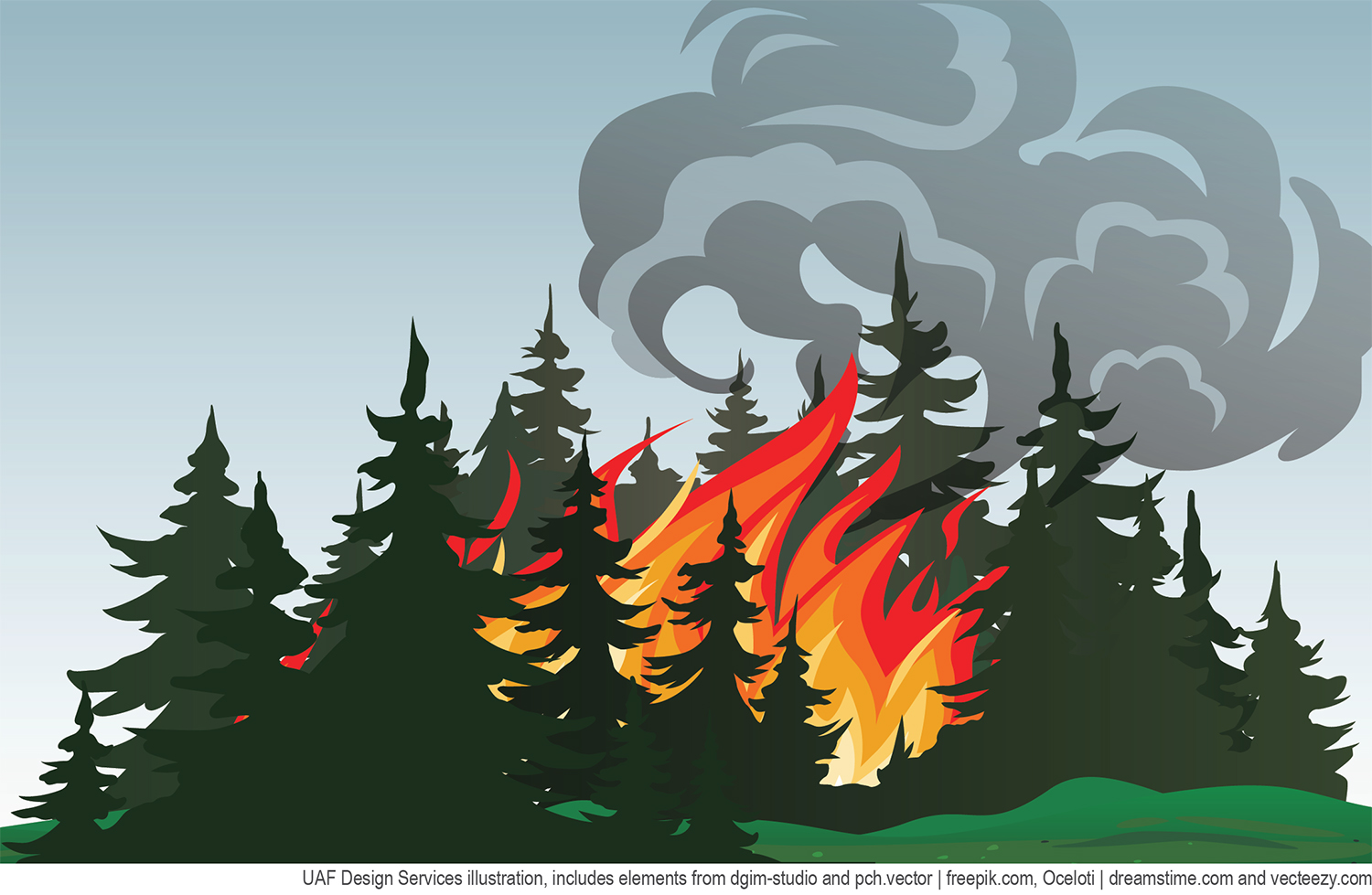
The Fire & Ice Diversity, Education and Workforce Development (DEW) component has developed a set of six fire lessons in collaboration with the BLM Campbell Creek Science Centerand the Fairbanks North Star Borough School District 21st Century Learning Program. The curriculum is designed for 3rd-5th grade learners but content can be adapted for lower or higher grade levels.
The curriculum engages students in observation and science sense-making through fun, interactive activities such as storytelling and gameplay. The lessons explore wildfire as a naturally occurring cycle that can be influenced by human activities.
Individual lessons, as well as an introduction to the curriculum entitled "Wildfire and Change in Alaska," are available below. You can find links to accompanying curriculum videos on our YouTube page.
- Wildfire and Change in Alaska
- Lesson #1: The Fire Cycle
- Lesson #2: The Fire Triangle
- Lesson #3: Introduction to Fire Behavior
- Lesson #4: Fire Behavior - Scenarios
- Lesson #5: Fire Behavior - Firefighters, Fuel Loads, Prescribed Burns
- Lesson #6: Fire Behavior - Weather and Chance
Podcasts
Fire & Ice Data Visualization Seed Grantee and UAF alumna Theresa Soley created a podcast called, "Ice and Fire," exploring climate change impacts in Alaska such as glacial recession through sound and storytelling.
Episodes are available for listening through podcast services, including Apple Podcasts, Spotify, Stitcher and Google Podcasts.
Informational Brochures
A brochure for the Fire & Ice project. Email ua-epscor@alaska.edu to arrange a pickup or dropoff of hard copies at the University of Alaska Fairbanks.
Fire & Ice collaborated with the Alaska Fire Science Consortium to produce a wildfire safety brochure based on interviews with wildfire agency staff and residents of the area devastated
by the 2019 McKinley Fire.
Recorded Events
Alaska EPSCoR produces various events and workshops. Below are recordings of some of the most noteworthy.
There are also recorded presentations from Fire & Ice researchers available from our annual All-Hands Meetings, as well as many engaging videos and other science communication products on our Highlights page.
Webinars & Workshops
Augmented Reality Basics Workshop
A 3-part workshop introducing basic steps for creating augmented reality mobile apps using Unity or AR Hero.
- Part 1: Overview (Passcode: f2T$l463)
- Part 2: What’s Your Mission? (Passcode: hh=5yUV5)
- Part 3: How to reach your vision (Passcode: y=d7r&Rt)
How to Get Published!
On September 14, 2023, Alaska EPSCoR invited three editors from the Journal of Experimental Marine Biology and Ecology to discuss the process of publishing research in peer-reviewed journals. Click here for the presentation slides.
Visualizing Science: Communicating concepts through graphic design
Password: G8hK+xAn
Also, a follow-up webinar(password: U2f?bxX).
Animated Visualizations
A three-part Animation Workshop from October 2021 that focused on the free software Blender.
The 2022 EPSCoR Natural History Workshop
A Zoom science primer including presentations on climate change by Rick Thoman, glaciers by Eric Klein, the aurora by Omega Smith; salmon by Molly McCarthy-Cunfer; and wildfire by Alison York.
The 2021 EPSCoR Natural History Workshop
A Zoom science primer including presentations on climate change by Rick Thoman, glaciers by Eric Klein, volcanoes by Brandon Browne, bears by Marian Snively, and the aurora borealis by Omega Smith.
The McKinley Fire - Rebuilding and Lessons Learned
A video in which area residents and fire crews discuss the 2019 McKinley Fire and what they've gleaned from the experience
The EPSCoR Student Ambassador Program's Employment Opportunities for Grad Students
Series
The EPSCoR Student Ambassador program has sponsored four presentations about employment opportunities, aimed at grad students. We have four of them here:
-
- Applying for Agency Jobs
- The NOAA Corps (passcode: 674L#=YG)
- Research careers outside academia, and resume writing(passcode: +Aq5!yHm)
- Working with nonprofits(passcode: e0?B&&X*)
- Applying for Agency Jobs
Game Jam
In June 2020 Alaska NSF EPSCoR held its first-ever Game Jam, in which participants from across the world competed to design video games on a Fire & Ice theme. EPSCoR ultimately received 7 entries, of which 5 are currently playable or downloadable online.
The first place winner was Extended Care Unit Room 19B, a text-based medical mystery by user "Ambrosio." Second was Climatic, a climate-based strategy game from "Blue Birdy. Third was a side-scrolling data-gathering adventure, Alaska DataQuest, by "casperquincy," which also won the "Best Use of Theme" award.
Science Pubs
The Wildfire and Wine Science Pub and the Glaciers to Wine Science Pub were informal presentations that discussed the respective impacts of wildfires and glaciers on the wine industry.


